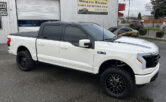
Paint Protection Film or Ceramic Coating. Which should I use for my new vehicle ?
With so much product information on the web, it can be difficult to ascertain which form of protection would be a better choice for your new vehicle, or possibly you should utilize both to provide different types of protection for different areas of your vehicle. In this article we will look at how the two products differ from each other and the type of protection that each product offers, so that you can make a better determination on how to protect and enhance the look of your paint for years to come.

First we will look at Paint Protection film.
As the name implies it is actually a flexible, transparent protective film or sheet. This film is made up of three layers.
- 1.6mm-thick acrylic adhesive that strongly bonds to your car’s paint surface.
- A 6mm polyurethane layer that protects the paint from damage by providing a thick, scratch-resistant coating over the paint. It also prevents paint chips by dissipating impact energy across a wider surface above the paint.
- A clear coat layer that protects the polyurethane layer against fading and stains.
Modern paint protection films, such as XPEL, also have self-healing properties that allow the PPF to literally “heal” itself from minor scratching and damage. The film’s multiple layers work together cohesively to protect the vehicle’s paint and “heal” surface-level damage to the film itself when heat is introduced to the film, such as direct solar energy, heat from the engine, or warm water rinsing.

Next we will look at Ceramic Coating for Paint.
Unlike Paint Protection Film, Ceramic coating is a liquid that is mainly composed of silicon dioxide (silica, Si02). This liquid is applied systematically to the paint and then methodically leveled to achieve its final state on the paint surface. And, unlike PPF which utilizes an adhesive to bond to the paint, ceramic coatings bond chemically to the paint surface. This strong molecular bond is what makes ceramic coatings more durable than waxes or sealants.
Ceramic coatings also provide protection against UV rays, PPF does not. Its hydrophobic properties repel dirt and liquids, making surfaces easier to clean. Ceramic coatings are extremely hard. When measured on the Mohs’ Scale most coatings measure in at approx 9H, which is approximately the measured hardness of diamonds. This makes the coating much more resistant to minor scratching than paint. The hardness of most modern paint’s clear or top coat measures between 1-4 on the Mohs’ scale.
Ceramic coating thickness: Most coatings are 1.5-2 microns thick per application. (You can utilize multiple applications to achieve greater thickness). In comparison a human hair is approximately 70 microns thick. Therefore Ceramic coatings are much thinner than PPF.
Now that you know what each product is, let’s take a look at how they are best utilized in the automotive environment.
Paint protection film. Its properties make it the best choice for protecting against rock chips and other flying debris. And its self healing properties protect against minor scuffs, scratches and contaminants. Because it is removable, it is often utilized as a sacrificial layer of protection against permanent paint damage and can be replaced on a regular basis. This is why paint protection film is most widely utilized on the front of the vehicle where paint damage from flying debris is most prevalent.
Ceramic Coating for Paint. Even though it is extremely hard, it is not thick enough to prevent damage from flying debris such as rock chips. It does however protect your paint from micro scratching and swirl marks as well as fading. It also makes the surface very smooth, filling in imperfections in the top coat beneath it making it difficult for dirt and contaminants to stick to the surface. And it gives paint a noticeable deep candy-like glossy appearance that can last for years.

Why not cover all painted surfaces with PPF? Many car owners protect all painted surfaces with PPF. However the cost is a bit prohibitive for most vehicle owners, with average costs exceeding $6,000 for a full paint wrap in PPF. While full paint coverage with a ceramic coating is usually one-third the cost or less.
With this being said, the most common option is to protect the front of the vehicle with PPF and then protect the rest of the paint with a ceramic coating. The same advantages that ceramic coatings offer for paint they also offer for many other surfaces including wheels, brake calipers, glass, plastic trim, interior fabrics, carpets, and leather. It is even recommended to protect PPF with ceramic coating.

Quick Recap:
Paint Protection Film is the best way to protect your vehicle from road hazards such as rock chips. And while many consider PPF to be the best way to protect all painted surfaces it is usually cost prohibitive, therefore it is mostly applied in high risk areas of the vehicle.
Ceramic Coatings protect surfaces with a super hard, micro thin hydrophobic coating that also enhances the appearance of paint and lasts much longer than other alternatives such as wax or paint sealants.
I hope this article provides some insight into the differences between PPF and Ceramic Coating for protecting your vehicle’s paint. If you have any questions at all about our products and pricing please feel free to contact us.




